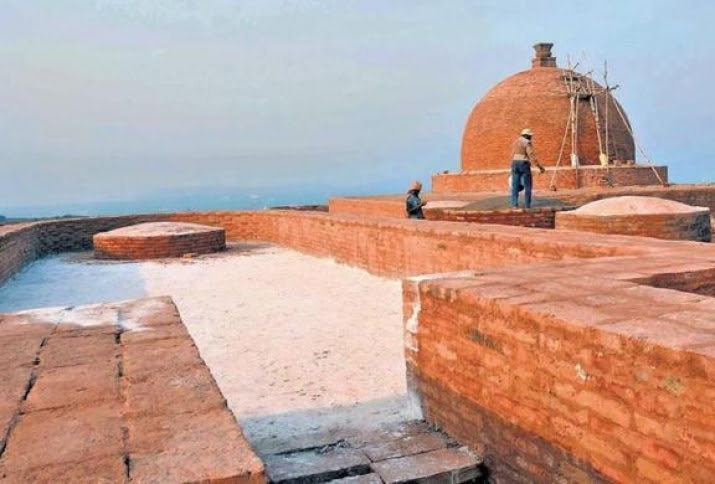By Shyamal Sinha, New Delhi

The ancient Buddhist complexes of Thotlakonda and Bavikonda in the southern Indian state of Andhra Pradesh have recently undergone extensive reconstruction under the supervision of the State Department of Archaeology and Museums, with the work scheduled to be completed by the end of this month. Bavikonda has been dated to the 3rd century BCE, while Thotlakonda flourished between the 2nd century BCE and the 2nd century CE and might have accommodated more than 100 monks at its peak.
“The bricks used in construction at these sites are very large unlike conventional bricks,” said Assistant Director of Archaeology K. Chitti Babu. “Large-size bricks had been specially ordered and ‘ganugu sunnam’ [a mixture of limestone and clay] is being used to replace the missing and damaged bricks. The brick walls and other structures in ancient constructions used to be held together by ‘ganugu sunnam’ and concrete was not used,” he added. (The Hindu)
“The Mahastupam [sic, Mahastupa], along with its five parts, 11 votive stupas, and three circularchaityagriha-s are some of the structures found here,” said Ch. Lakshmana, a tour guide at Thotlakonda, adding, “The vruttakara [curved or circular] chaityagriha, with two entrances, one on the East and the other on the West, is unique to this site and has features of Roman architecture.” (The Hindu)
To encourage tourism at the sites, a Buddhist gallery, interpretation centers, a souvenir shop, and a luggage room have been provided as part of the renovation initiative, as well as drinking water, a snack bar, and restrooms.
Neerabh K. Prasad, principal secretary (tourism and culture) for Andhra Pradesh, told The Hindunewspaper, “Our aim is to set up tourist amenities away from the protected monuments under the supervision of archaeological experts to attract more tourists. The Department of Archaeology and Museums has been entrusted with the scientific restoration and reconstruction of the structures at these sites.”

Meanwhile, a recently discovered Buddhist site, believed to date from the 2nd–4th century CE, has been excavated in the Margalla Hills. north of Islamabad, with conservation work by Pakistan’s Department of Archeology and Museums (DOAM) expected to begin soon.
The site, Ban Faqiran, excavated under the field directorship of Abdul Ghafoor Lone and site supervisor Arshad Kha, includes a large, square stupa-like structure measuring 10.26 meters (about 33 feet) on each side and made of limestone and kanjur (a porous form of sedimentary stone), with semi-ashlar and diaper masonry.
Funding for the excavation and conservation was provided by Pakistan’s National Fund for Cultural Heritage in April 2015, with excavation initiated in August 2015. The project carries a total cost of Rs2 million (US$19,100).
A number of valuable antiquities, including six coins and four iron arrowheads, have been unearthed at the site, which also includes a water tank and an early mosque. The artifacts are to be housed at a museum for research, educational purposes, and promoting tourism.If really both the neighboring countries want to promote the historical tourism they have to preserve the buddhist heritage site to increase the tourist traffic also.












